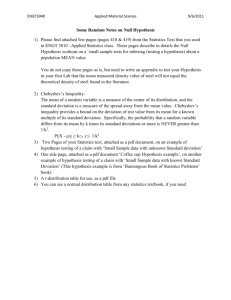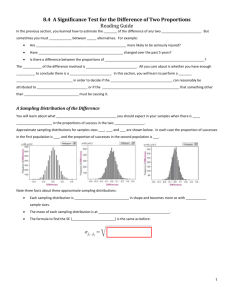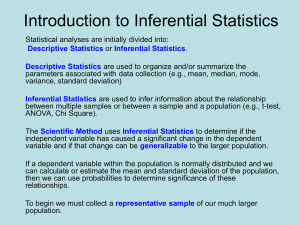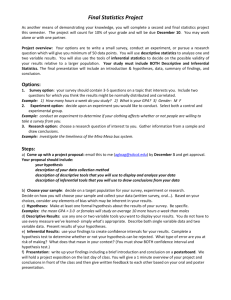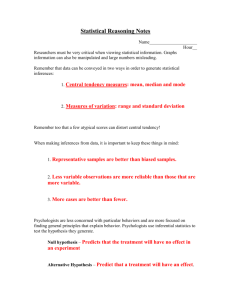AP Statistics Vocabulary List
advertisement
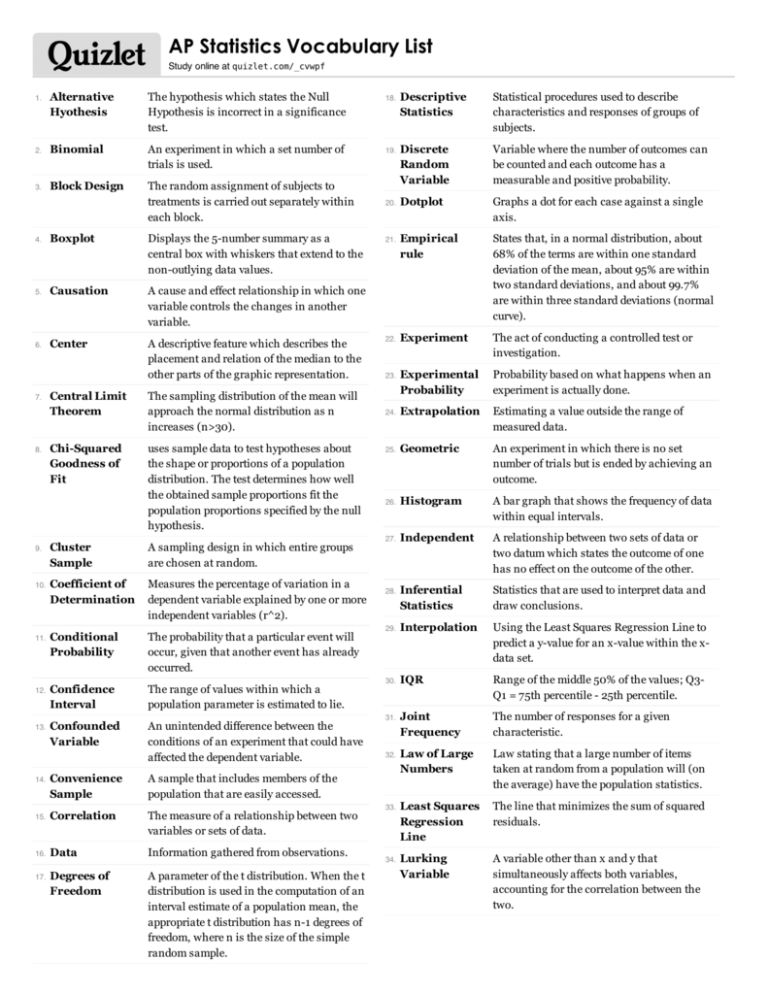
AP Statistics Vocabulary List Study online at quizlet.com/_cvwpf Alternative Hyothesis The hypothesis which states the Null Hypothesis is incorrect in a significance test. 2. Binomial An experiment in which a set number of trials is used. 3. Block Design The random assignment of subjects to treatments is carried out separately within each block. 1. 4. Boxplot Displays the 5-number summary as a central box with whiskers that extend to the non-outlying data values. 5. Causation A cause and effect relationship in which one variable controls the changes in another variable. 6. Center A descriptive feature which describes the placement and relation of the median to the other parts of the graphic representation. 7. 8. 9. 10. 11. 12. 13. Central Limit Theorem The sampling distribution of the mean will approach the normal distribution as n increases (n>30). Chi-Squared Goodness of Fit uses sample data to test hypotheses about the shape or proportions of a population distribution. The test determines how well the obtained sample proportions fit the population proportions specified by the null hypothesis. Cluster Sample A sampling design in which entire groups are chosen at random. Coefficient of Determination Measures the percentage of variation in a dependent variable explained by one or more independent variables (r^2). Conditional Probability The probability that a particular event will occur, given that another event has already occurred. Confidence Interval The range of values within which a population parameter is estimated to lie. Confounded Variable An unintended difference between the conditions of an experiment that could have affected the dependent variable. Convenience Sample A sample that includes members of the population that are easily accessed. 15. Correlation The measure of a relationship between two variables or sets of data. 16. Data Information gathered from observations. Degrees of Freedom A parameter of the t distribution. When the t distribution is used in the computation of an interval estimate of a population mean, the appropriate t distribution has n-1 degrees of freedom, where n is the size of the simple random sample. 14. 17. Descriptive Statistics Statistical procedures used to describe characteristics and responses of groups of subjects. Discrete Random Variable Variable where the number of outcomes can be counted and each outcome has a measurable and positive probability. Dotplot Graphs a dot for each case against a single axis. Empirical rule States that, in a normal distribution, about 68% of the terms are within one standard deviation of the mean, about 95% are within two standard deviations, and about 99.7% are within three standard deviations (normal curve). Experiment The act of conducting a controlled test or investigation. Experimental Probability Probability based on what happens when an experiment is actually done. 24. Extrapolation Estimating a value outside the range of measured data. 25. Geometric An experiment in which there is no set number of trials but is ended by achieving an outcome. 26. Histogram A bar graph that shows the frequency of data within equal intervals. 27. Independent A relationship between two sets of data or two datum which states the outcome of one has no effect on the outcome of the other. Inferential Statistics Statistics that are used to interpret data and draw conclusions. 29. Interpolation Using the Least Squares Regression Line to predict a y-value for an x-value within the xdata set. 30. IQR Range of the middle 50% of the values; Q3Q1 = 75th percentile - 25th percentile. Joint Frequency The number of responses for a given characteristic. Law of Large Numbers Law stating that a large number of items taken at random from a population will (on the average) have the population statistics. Least Squares Regression Line The line that minimizes the sum of squared residuals. Lurking Variable A variable other than x and y that simultaneously affects both variables, accounting for the correlation between the two. 18. 19. 20. 21. 22. 23. 28. 31. 32. 33. 34. 35. 36. 37. 38. 39. 40. 41. 42. 43. 44. Margin of Error Marginal Frequency Matched Pairs Mean Median The range of percentage points in which the sample accurately reflects the population, the range surrounding a sample's response within which researchers are confident the larger population's true response would fall. Row and column totals in a contingency table (cross-tabulation) that represent the univariate frequency distributions for the row and column variables. Either two measurements are taken on each individual such as pre and post OR two individuals are matched by a third variable (different from the explanatory variable and the response variable) such as identical twins. The arithmetic average of a distribution, obtained by adding the scores and then dividing by the number of scores. The middle score in a distribution; half the scores are above it and half are below it. Mode The datum which occurs the most in a set of data. Mutually Exclusive Each event or variable is independent from one another. No event or variable will have an effect on the probability of outcome for any other event or variable. NonResponse Bias A bias caused by a number of people who did not respond to the survey. Normal A sample which follows the Empirical Rule for distribution. Null Hypothesis The hypothesis that states there is no difference between two or more sets of data in a significance test. 51. Population The entire aggregation of items from which samples can be drawn. 52. Probability The likelihood that a particular event will occur. 53. Qualitative Data identified by something other than numbers. 54. Quantitative Data or datum being numerically defined. Quota Sample A sample deliberately constructed to reflect several of the major characteristics of a given population. Random Sample A sample in which every element in the sample has an equal chance of being selected. Residual The difference between an observed value of the response variable and the value predicted by the regression line. Response Bias Anything in the survey design that influences the responses from the sample. 59. Sample Items selected at random from a population and used to test hypotheses about the population. 60. Sample Space All possible outcomes of an experiment. Sampling Distribution The distribution of values taken by the statistic in all possible samples of the same size from the same population. Scatterplot A graphed cluster of dots, each of which represents the values of two variables. Simple Random Sample Every member of the population has a known and equal chance of selection. Simulation The act of repeating an experiment to get more accurate statistical evidence. Snowball Sample Samples in which informants provide contact information about other people who share some of the characteristics necessary for a study. Spread A descriptive feature in which describes the range of the data graphically. Standard Deviation A measure of variability that describes an average distance of every score from the mean (r). Standard Error The standard deviation of a sampling distribution. Standardized Value A value found by subtracting the mean and dividing by the standard deviation. Statistic A numerical measurement describing some characteristic of a sample. 55. 56. 57. 58. 61. 62. 63. 64. 65. Observational Study An experiment which observes individuals and measures variables of interest but does not attempt to influence the responses. 46. Ogive A line graph that depicts cumulative frequencies. 66. 47. Outlier An extreme deviation from the mean. 67. 48. p-Value The probability of getting a result at least as extreme as the result given from the test. The lower the value the stronger the evidence. 45. 49. 50. Parameter Placebo Effect A numerical measurement describing some characteristic of a population. Experimental results caused by expectations alone; any effect on behavior caused by the administration of an inert substance or condition, which is assumed to be an active agent. 68. 69. 70. Statistical Significance When your discovered p-value is less than your alpha (.05 if not given). States that chance alone would rarely produce an equally extreme result. 72. Stemplot A graphical representation of a quantitative data set. Leading values of each data point are presented as stems and second digits are given as leaves. 73. Stratified Sample The population is divided into strata and a random sample is taken from each stratum. Systematic Sample A sample drawn by selecting individuals systematically from a sampling frame. t-Test A parametric inferential statistical test of the null hypothesis for a single sample where the population standard deviation is unknown. Theoretical Probability The ratio of the number of favorable outcomes to the number of possible outcomes if all outcomes have the same chance of happening. 77. Two-way Table A table containing counts for two categorical variables. It has r rows and c columns. 78. Type I Error An error that occurs when a researcher concludes that the independent variable had an effect on the dependent variable, when no such relation exists; a false positive. 79. Type II Error An error that occurs when a researcher concludes that the independent variable had no effect on the dependent variable, when in truth it did; a false negative. 80. Undercoverage Occurs when some groups in the population are left out of the process of choosing the sample. Voluntary Response Bias Bias introduced to a sample when individuals can choose on their own whether to participate in the sample. 82. Wording Bias A type of response bias where the question is posed to achieve a desired result. 83. z-Test A parametric inferential statistical test of the null hypothesis for a single sample where the population standard deviation is known. 71. 74. 75. 76. 81.


